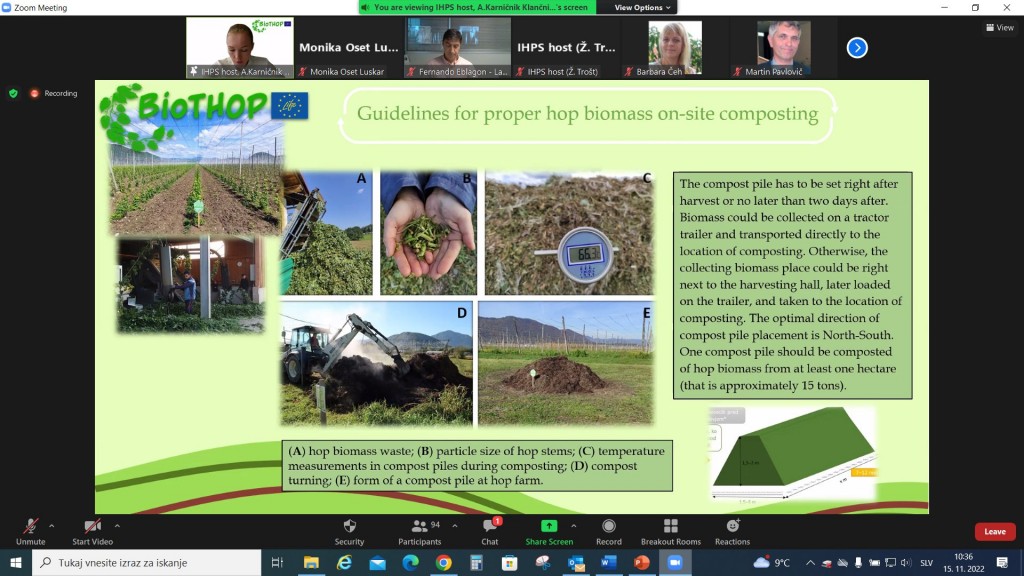SI Rezultate kompostiranja hmeljevine je na zaključni konferenci BioTHOP predstavila Ana Karničnik iz IHPS. Pojasnila je, da je kompostiranje zelo dobra možnost za ravnanje z odpadno hmeljevino, ki je prepletena z biorazgradljivo PLA vrvico. Hmeljevina (750 t) po obiranju je bila v vseh treh letih projekta zbrana in kompostirana 7 mesecev po različnih protokolih. Preizkušenih je bilo več kot 10 različnih protokolov. IHPS je tesno sodeloval z 12 hmeljarji. Nekaj kompostnih kupov je bilo postavljenih na IHPS, večina pri hmeljarjih. Vsi kompostni kupi so bili analizirani glede kakovosti komposta in razpada vrvice. Za oceno kakovosti komposta so bili opravljeni kemijski in biološki testi. Kemijska sestava kaže na primernost za uporabo komposta na njivah. Kombinacija majhnih delcev biomase in pogosto obračanje kupa sta najbolj pomembna dejavnika za učinkovito kompostiranje PLA vrvice. Kompostirana hmeljevina omogoča ustrezno razpoložljivost hranil in s tem mikrobno razgradnjo do optimalnega/zrelega komposta v 7 mesecih. Poskus zbiranja izcednih vod je pokazal, da je treba kompost pozno jeseni pokriti, da preprečimo izgube hranil.
IHPS je v sodelovanju z Ministrstvom za okolje in prostor RS ter Ministrstvom za kmetijstvo in gozdarstvo RS pripravil smernice za ravnanje s hmeljevino po obiranju. Smernice so objavljene na spletnih straneh BioTHOP in IHPS.
EN On-site hop biomass composting results were presented at the BioTHOP final conference by Ana Karničnik from IHPS. She explained that the results showed, composting is a very good option to deal with waste hop biomass, intertwined with supporting biodegradable BioTHOP PLA twine for hop growers. Hop biomass (750 t) after harvest was collected in all those three years and composted for 7 months according to different protocols. Over 10 different protocols were tested. IHPS worked in close collaboration with 12 hop growers. Some composting piles were set at IHPS, the majority over hop growers. All mature composting piles were analysed for compost quality and twine degradation. Chemical and biological tests were performed in order to assess the compost quality. Chemical composition indicates suitability for compost use in arable land. The combination of small particles of biomass and frequent turning of the pile are two most promising factors for efficient composting of PLA twine. Composted hop biomass without additives enables proper availability of nutrients and thus microbial decomposition to optimal/mature compost within 7 months. The leachate collecting experiment showed the need of covering the compost in late autumn to avoid nutrient loss.
IHPS prepared guidelines for the post-harvest management of hop biomass on hop farms in collaboration with the Ministry for Environment and Spatial Planning of the Republic Slovenia and the Ministry for Agriculture and Forestry of RS. Guidelines are published on the BioTHOP and IHPS websites.

